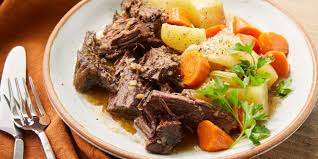Why Pot Roast Belongs in Your Dinner
There are a very few dishes that bring joy to our dinner pot roast dishes are one of them just because:
Budget-friendly – Tough cuts become tender and luxurious
One-pot wonder – Minimal cleanup, maximum flavor
Meal prep hero – Tastes even better as leftovers
Versatile canvas – Adaptable to countless flavor profiles
The Science of Perfect Pot Roast
Understanding the magic behind pot roast helps guarantee success every time:
Collagen Breakdown: Tough connective tissues in chuck roast melt into gelatin during slow cooking, creating that signature fork-tender texture.
Maillard Reaction: Proper searing develops hundreds of flavor compounds for deeper, richer taste.
Carryover Cooking: Resting allows juices to redistribute throughout the meat.
Choosing Your Cut: A Meat Buyer’s Guide
| Cut | Best For | Cooking Time | Fat Content |
|---|---|---|---|
| Chuck Roast | Classic pot roast | 3-4 hours | Well-marbled |
| Brisket | Intense beef flavor | 4-5 hours | Moderate |
| Bottom Round | Leaner option | 3-4 hours | Low |
| Short Ribs | Ultra-rich results | 4-5 hours | Very high |
The Definitive Pot Roast Recipe
Ingredients
-
3-4 lb chuck roast
-
2 tbsp avocado oil
-
1 lb baby potatoes
-
3 large carrots, chunked
-
2 celery ribs, sliced
-
1 onion, diced
-
4 garlic cloves, smashed
-
2 cups beef stock
-
1 cup red wine (substitute with broth if preferred)
-
2 tbsp tomato paste
-
1 tbsp Worcestershire sauce
-
3 rosemary sprigs
-
2 bay leaves
Step-by-Step Method
-
The Sear (5 minutes per side):
-
Pat roast dry, season aggressively with salt and pepper
-
Heat oil in Dutch oven until smoking
-
Develop deep crust on all surfaces
-
-
Aromatics (8 minutes):
-
Sauté onions until translucent
-
Add garlic, cook until fragrant
-
Deglaze with wine, scraping fond
-
-
The Braise (3 hours at 300°F):
-
Return meat to pot, add remaining ingredients
-
Liquid should come halfway up roast
-
Cover tightly, oven-braise until fork-tender
-
-
The Finish:
-
Remove meat, strain vegetables
-
Reduce braising liquid by half for sauce
-
Skim excess fat before serving
-
Modern Cooking Methods Compared
Traditional Dutch Oven:
-
Pros: Superior browning, even heat
-
Cons: Requires oven space
Slow Cooker:
-
Pros: Hands-off convenience
-
Cons: Less flavor development
Instant Pot:
-
Pros: 90 minute cook time
-
Cons: Texture slightly different
Sous Vide:
-
Pros: Perfect edge-to-edge doneness
-
Cons: No crust without finishing step
Elevated Flavor Variations
-
Coffee-Rubbed with espresso powder and cocoa
-
Asian-Inspired with star anise and soy sauce
-
Provençal with herbes de Provence and olives
-
Mexican with chipotle and orange zest
-
Umami Bomb with dried mushrooms and miso
Troubleshooting Common Issues
Problem: Tough, dry meat
Solution: Cook longer at lower temperature
Problem: Bland flavor
Solution: Use better stock, don’t skimp on salt
Problem: Greasy sauce
Solution: Chill to solidify fat, then remove
Problem: Mushy vegetables
Solution: Add in final 45 minutes of cooking
Serving Suggestions
Classic Pairings:
-
Creamy polenta
-
Buttered egg noodles
-
Crusty bread for soaking
Modern Twists:
-
Gremolata garnish
-
Roasted root vegetable mash
-
Quick-pickled vegetables
The Leftover Playbook
-
Beef Pot Pie with flaky crust
-
Ragu over pappardelle
-
Tacos with pickled onions
-
Philly Cheesesteak sandwiches
-
Shepherd’s Pie topping
Nutrition Breakdown
A 6-oz serving provides:
-
380 calories
-
42g protein
-
22g fat
-
Iron, zinc, and B vitamins
Expert Tips from Butchers
-
“Ask for the chuck eye roll – it’s the most tender part”
-
“Dry brine overnight for deeper seasoning”
-
“Save bones to make stock for next time”
-
“Slice against the grain for maximum tenderness”
Conclusion
Mastering pot roast means mastering the alchemy of patience and technique. This humble dish represents culinary tradition at its finest – transforming modest ingredients into extraordinary meals through time-honored methods.
